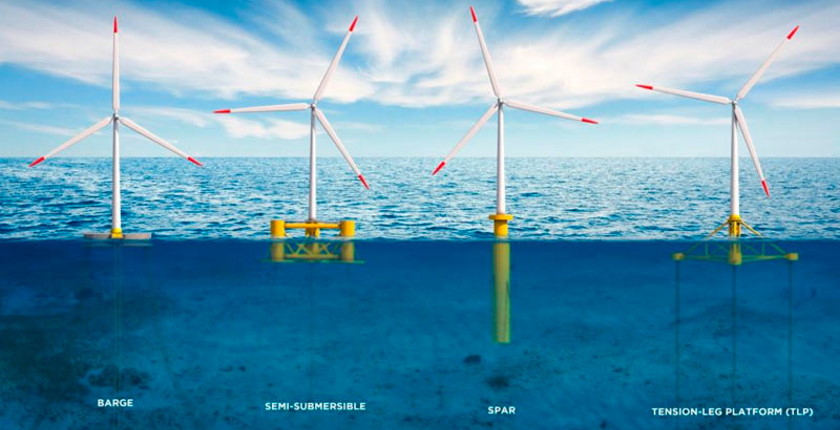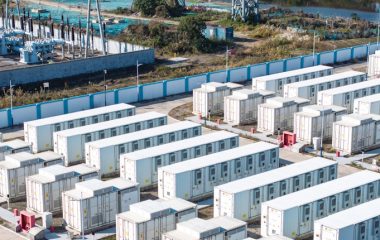
Photo: WindEurope
Floating wind power plants are the solution for the world’s coastal regions with waters deeper than 60 meters, GWEC said and estimated they make up 80% of the overall potential for the deployment of offshore wind. There are five Balkan countries in its list of 30 markets that can evolve rapidly.
Offshore wind is a low-cost, secure power source for global decarbonization efforts, according to a new report issued by Global Wind Energy Council (GWEC). The document identifies floating offshore wind technology’s critical role in cutting the use of fossil fuels and reaching climate neutrality by 2050. It points to Ireland, Italy, Morocco, Philippines and the United States as the countries with the biggest potential.
With 80% of the world’s offshore wind resources situated in waters deeper than 60 meters, traditional bottom-fixed offshore wind turbines are either not an option or at best a limited option for many coastal regions, authors the report called Floating Offshore Wind – a Global Opportunity said. It was commissioned from Aegir Insights.
Floating technology allows wind turbines to be positioned in deep open sea without the need for fixed foundations, reducing the impact on the environment and increasing efficiency. Investors are also counting on less opposition from the local population as the facilities are further away from the shore.
Ireland, Italy seen as biggest emerging markets for floating wind in Europe
The most mature floating wind markets are the United Kingdom – home to the world’s largest facility of the kind, South Korea, France and Japan, the document reads.
The five emerging countries in the sector can catch up to them if they put the right policy in place, GWEC stressed. They have a combined floating offshore wind technical potential of 3.86 TW, equivalent to between 2.6 times – for Italy – and an astonishing 69 times – for Ireland – their current electricity demand.
GWEC: Global offshore wind farm capacity needs to reach 2 TW by 2050 to cut net emissions to zero
The longer list contains 30 countries with the best potential, of which five are in Southeastern Europe: Bulgaria, Turkey, Romania, Greece and Croatia.
“While the focus of this decade is rapid growth of fixed offshore wind, we also need to see political leadership so that floating offshore wind is ready to play its part,” the organization’s Chief Executive Officer Ben Backwell said.
GWEC said global offshore wind farm capacity needs to reach 2 TW by 2050 to cut net emissions to zero, compared to 35 GW from 2020 and a 270 GW target for 2030.
Italy is yet to commission its first offshore wind power plant
Italy’s lack of space on land and the absence of sites suitable for fixed-bottom wind will drive a focus onto floating offshore wind, the report adds. The best sites are near Sardinia and in the Strait of Sicily. There is also great potential between Brindisi and the Strait of Otranto, which connects the Adriatic and the Ionian Sea, and offshore Calabria at Catanzaro in the Ionian Sea.
Italy has modest ambitions for offshore wind compared to the number and size of projects in the pipeline
Italy aims to increase wind power from the current 10.5 GW to 18.4 GW by 2030. Only 900 MW is envisaged for offshore wind, but National Wind Energy Association – ANEV has a target of 5 GW just for floating offshore wind for 2040.
The country’s first fixed-bottom offshore wind farm should be connected to the grid this year. The project for the 30 MW facility near Taranto was launched in 2010.
Last October, Italy’s transmission system operator Terna said it received 39 grid connection applications from offshore wind projects.
Greece has potential for 30 GW in floating wind
As for Greece, Energypress recently learned that the government identified potential in studies for 40 GW in offshore wind in areas up to six miles from the coast, of which 30 GW would be for floating units. The media outlet added the first auction is planned to be held for 2 GW.
The other countries in the region still have no operational offshore wind capacity. Oil and gas platforms in the Adriatic could be transformed into wind turbines when the fossil fuel reserves are depleted.
The largest fixed-bottom offshore wind system is the UK’s Hornsea 1, with 1.2 GW. It is set to be surpassed next year by Hornsea 2. The world’s largest project under development is called Sinan. The South Korean facility is planned for 8.2 GW.
OX2 has just applied for a Natura 2000 permit for its 5.5 GW project called Aurora, planned for a site in the Swedish Baltic Sea Exclusive Economic Zone, making it second by size in the pipeline on a global scale.


















Be the first one to comment on this article.